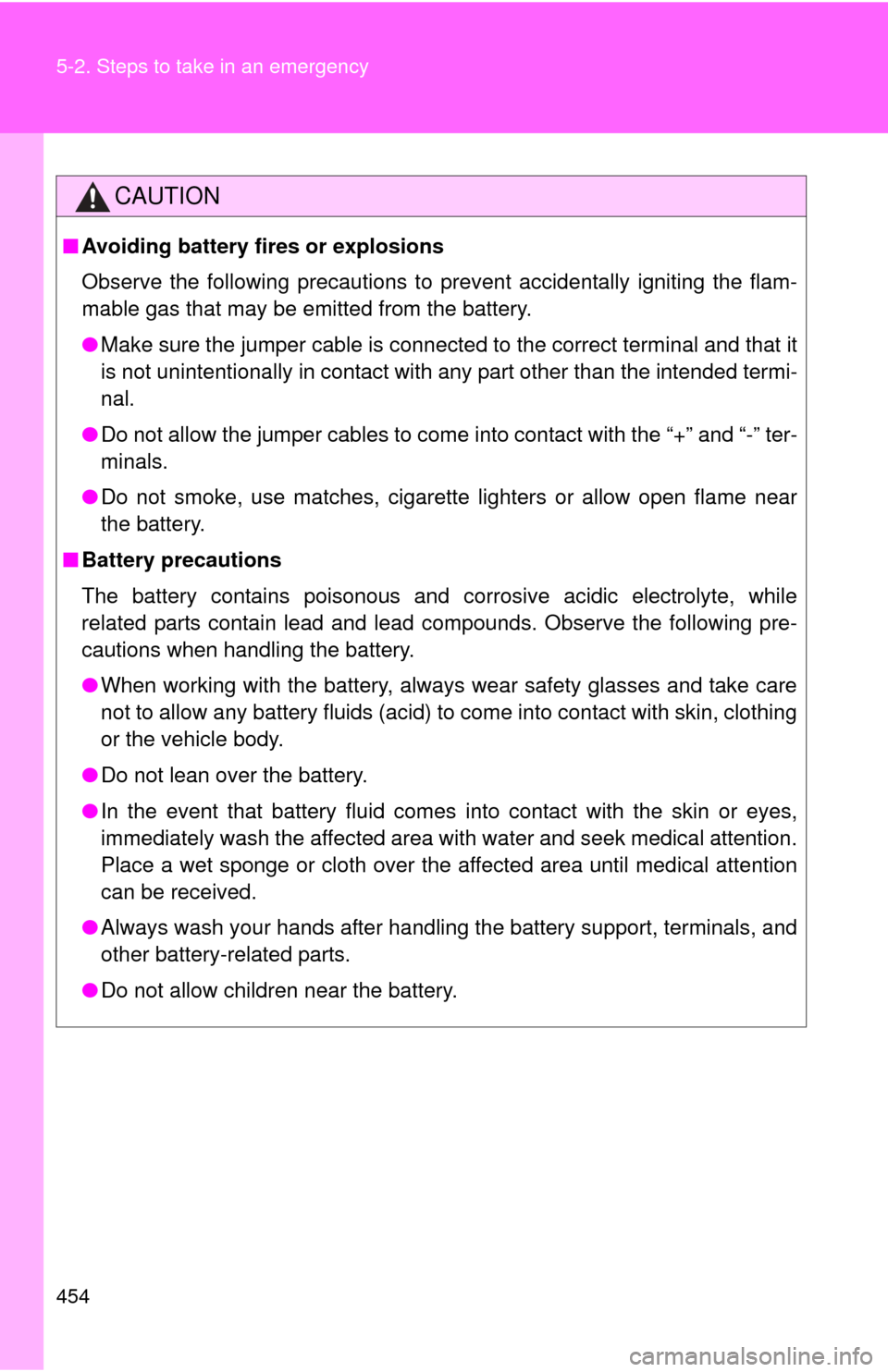2012 TOYOTA COROLLA battery
[x] Cancel search: batteryPage 452 of 529

452 5-2. Steps to take in an emergency
Once the vehicle’s engine has started, remove the jumper
cables in the exact reverse order in which they were con-
nected.
Once the engine starts, have the vehicle checked at your Toyota
dealer as soon as possible.
2.4 L 4-cylinder (2AZ-FE) engine
Connecting the jumper cables Positive (+) battery terminal on your vehicle
Positive (+) battery terminal on the second vehicle
Negative (-) battery terminal on the second vehicle
Connect the jumper cable to ground on your vehicle as shown in
the illustration. Start the engine of the second vehicle. Increase the engine
speed slightly and maintain at that level for approximately 5
minutes to recharge the battery of your vehicle.STEP 6
STEP 1
STEP 2
Page 453 of 529

5
When trouble arises
453
5-2. Steps to take in an emergency
■
Avoiding a discharged battery
●Turn off the headlights and the audio system while the engine is turned
off.
● Turn off any unnecessary electrical components when the vehicle is run-
ning at a low speed for an extended period, such as in heavy traffic, etc.
■ Charging the battery
The electricity stored in the battery will discharge gradually even when the
vehicle is not in use, due to natural discharge and the draining effects of cer-
tain electrical appliances. If the vehicle is left for a long time, the battery may
discharge, and the engine may be unable to start. (The battery recharges
automatically during driving.)
Maintain the engine speed of the second vehicle, and turn
the engine switch to the “ON” position, then start the vehi-
cle's engine.
Once the vehicle’s engine has started, remove the jumper
cables in the exact reverse order in which they were con-
nected.
Once the engine starts, have the vehicle checked at your Toyota
dealer as soon as possible.STEP 3
STEP 4
Page 454 of 529

454 5-2. Steps to take in an emergency
CAUTION
■Avoiding battery fires or explosions
Observe the following precautions to prevent accidentally igniting the flam-
mable gas that may be emitted from the battery.
●Make sure the jumper cable is connected to the correct terminal and that it
is not unintentionally in contact with any part other than the intended termi-
nal.
● Do not allow the jumper cables to come into contact with the “+” and “-” ter-
minals.
● Do not smoke, use matches, cigarette lighters or allow open flame near
the battery.
■ Battery precautions
The battery contains poisonous and corrosive acidic electrolyte, while
related parts contain lead and lead compounds. Observe the following pre-
cautions when handling the battery.
●When working with the battery, always wear safety glasses and take care
not to allow any battery fluids (acid) to come into contact with skin, clothing
or the vehicle body.
● Do not lean over the battery.
● In the event that battery fluid comes into contact with the skin or eyes,
immediately wash the affected area with water and seek medical attention.
Place a wet sponge or cloth over the affected area until medical attention
can be received.
● Always wash your hands after handling the battery support, terminals, and
other battery-related parts.
● Do not allow children near the battery.
Page 472 of 529

472 6-1. Specifications
Electrical system
Manual transmission
Battery
Open voltage at
68F (20 C): 12.6 12.8 V Fully charged
12.2 12.4 V Half charged
11 . 8
12.0 V Discharged
(Voltage checked 20 minutes after the
engine and all the lights turned off)
Charging rates 5 A max.
Gear oil capacity (Reference) 1.8 L 4-cylinder (2ZR-FE) engine
2.0 qt. (1.9 L, 1.7 Imp. qt.) 2.4 L 4-cylinder (2AZ-FE) engine
2.6 qt. (2.5 L, 2.2 Imp. qt.)
Gear oil type Use either of the following:
• “TOYOTA Genuine Manual Transmission Gear Oil LV”
• Other gear oil that meets API GL-4 and SAE 75W specifications
NOTICE
■ Manual transmission gear oil
Please be aware that depending on the particular characteristics of the gear
oil used or the operating conditions, idle sound, shift feeling and/or fuel effi-
ciency may be different or affected. Toyota recommends to use “TOYOTA
Genuine Manual Transmission Gear Oil LV” to achieve optimal performance.
Page 486 of 529

486 6-1. Specifications
Tire related termMeaning
Normal occupant
weight 150 lb. (68 kg) times the number of occupants
specified in the second column of Table 1
* that
follows
Occupant distribution Distribution of occupants in a vehicle as speci-
fied in the third column of Table 1
* below
Production options
weight The combined weight of installed regular pro-
duction options weighing over 5 lb. (2.3 kg) in
excess of the standard items which they
replace, not previously considered in curb
weight or accessory weight, including heavy
duty brakes, ride levelers, roof rack, heavy duty
battery, and special trim
Rim A metal support for a tire or a tire and tube
assembly upon which the tire beads are seated
Rim diameter
(Wheel diameter) Nominal diameter of the bead seat
Rim size designation Rim diameter and width
Rim type designation The industry manufacturer's designation for a
rim by style or code
Rim width Nominal distance between rim flanges
Vehicle capacity
weight (Total load
capacity) The rated cargo and luggage load plus 150 lb.
(68 kg) times the vehicl
e's designated seating
capacity
Vehicle maximum load
on the tire The load on an individual tire that is determined
by distributing to each axle its share of the
maximum loaded vehicle weight, and dividing
by two
Vehicle normal load
on the tire The load on an individual tire that is determined
by distributing to each axle its share of curb
weight, accessory weight, and normal occu-
pant weight (distributed in accordance with
Ta b l e 1
* below), and dividing by two
Page 515 of 529

515
Alphabetical index
Back-up lights
Replacing light bulbs ............ 399
Wattage ................................ 475
Battery Checking .............................. 364
If the vehicle has a
discharged battery ............. 450
Preparing and checking
before winter ...................... 181
Bluetooth
® audio..................... 279
Bluetooth® phone ................... 279
Bottle holder ............................ 319
Brake Fluid...................................... 361
Parking brake ....................... 147
Brake assist ............................. 173
Break-in tips ............................ 123 Care
Exterior ..................................334
Interior ...................................336
Seat belts ..............................337
Cargo capacity .........................177
CD changer ...............................236
CD player ..................................236
Chains .......................................181
Child restraint system
Booster seats, definition ........103
Booster seats, installation .....107
Convertible seats, definition .............................103
Convertible seats,
installation ...........................107
Front passenger occupant classification system .............98
Infant seats, definition ...........103
Infant seats, installation.........107
Installing CRS with LATCH anchors ...............................108
Installing CRS with seat belts ............................110
Installing CRS with top tether straps ........................114
BC
Page 516 of 529

516 Alphabetical index
Child safetyAirbag precautions ..................93
Battery precautions ....... 365, 454
Child restraint system............ 103
Child-protectors .......................42
How your child should wear
the seat belt ..........................62
Installing child restraints ........ 107
Moon roof precautions ............76
Power window lock switch.......71
Power window precautions .....72
Removed key battery
precautions ......................... 388
Seat belt comfort guide ........... 59
Seat belt extender
precautions ...........................65
Seat belt precautions ..............64
Seat heater precautions ........ 326
Trunk precautions ...................49
Child-protectors .........................42
Cleaning
Exterior .................................. 334
Interior ................................... 336
Seat belts .............................. 337
Clock ......................................... 322
Compass ................................... 329
Condenser ................................ 361
Console box ............................. 312
Cooling system Engine overheating ............... 456
Cruise control........................... 169
Cup holder ................................ 314
Curtain shield airbags ...............86
Customizable features............. 491 Daytime running light
system .................................... 162
Defogger Rear window ......................... 219
Side mirror ............................ 219
Dimension ................................ 464
Dinghy towing ................... 201,202
Display Trip information ..................... 156
Do-it-yourself maintenance .... 345
Doors Door lock ..................... 25, 36, 41
Door windows ......................... 71
Side mirrors............................. 69
Driver's seat belt reminder light ......................................... 422
Driving
Break-in tips .......................... 123
Correct posture ....................... 84
Procedures............................ 120
Winter driving tips ................. 181D
Page 517 of 529

517
Alphabetical index
Electric power steering........... 173
Electronic key
If your electronic key battery is discharged .......... 448
Emergency flashers
Switch ................................... 412
Emergency, in case of If a warning light turns on ..... 420
If the electronic key does
not operate properly ........... 448
If the engine will not start...... 444
If the shift lever cannot be
shifted from P ..................... 446
If the vehicle has a
discharged battery ............. 450
If the warning buzzer sounds ............................... 420
If you have a flat tire ............ 432
If you lose your keys............. 447
If you think something is wrong ................................. 418
If your vehicle becomes stuck................................... 459
If your vehicle has to be stopped in an emergency... 461
If your vehicle needs to be
towed ................................. 413
If your vehicle overheats ...... 456 Engine
Compartment ........................354
Engine switch ................131, 135
Hood......................................349
How to start the
engine .........................131, 135
Identification number .............464
If the engine will not start ......444
Ignition switch................131, 135
Overheating...........................456
Engine coolant
Capacity ................................471
Checking ...............................360
Preparing and checking before winter .......................181
Engine coolan t temperature
gauge ......................................149
Engine immobilizer system.......81
Engine oil Capacity ................................468
Checking ...............................356
Preparing and checking before winter .......................181
Engine switch light ..................307
EPS ............................................173
Event data recorder ...................17E